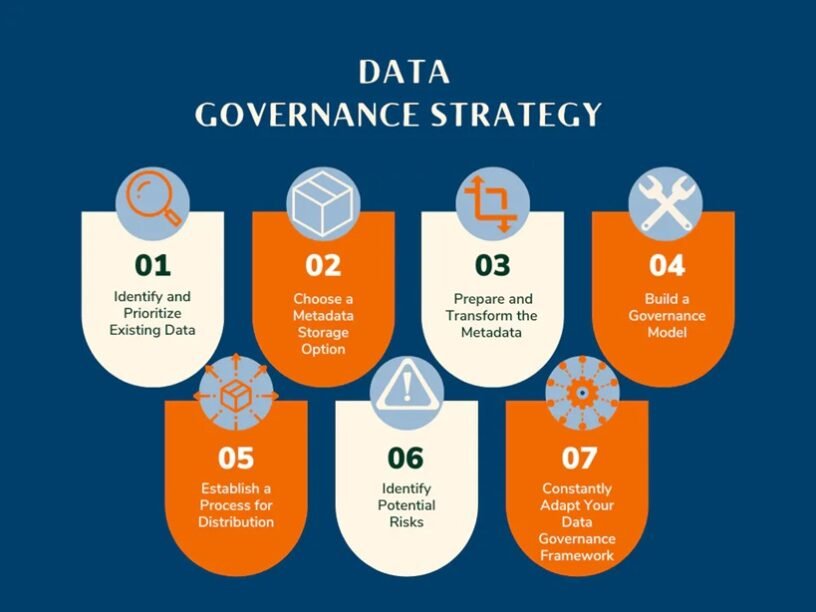Table of Contents
Hey there, fellow data enthusiasts!
Today, we’re diving into a hot topic that’s shaking up the data world: how Artificial Intelligence (AI) is revolutionizing data governance. Whether you’re a seasoned data pro or just getting your feet wet, understanding this trend is crucial. Let’s break it down together, shall we?
What is Data Governance?
Before we jump into the AI part, let’s clarify what data governance is. In a nutshell, data governance involves managing the availability, usability, integrity, and security of the data in enterprise systems. It’s all about ensuring that data is accurate, consistent, and accessible for those who need it while protecting it from misuse.
The AI Revolution in Data Governance
AI is not just a buzzword anymore; it’s a game-changer, especially in the realm of data governance. Here’s how AI is making a massive impact:
1. Automating Data Quality Management
One of the biggest challenges in data governance is maintaining data quality. Traditional methods can be tedious and error-prone. Enter AI. With machine learning algorithms, AI can continuously monitor and cleanse data. For example, AI can detect and correct errors in data sets, ensuring that the information used for decision-making is accurate.
Real-life example: Think of a financial institution that needs to ensure the accuracy of transaction records. AI can automatically identify anomalies in transaction data, flagging potential fraud or errors much faster than a human could.
2. Enhancing Data Security and Privacy
With data breaches becoming more common, securing sensitive information is a top priority. AI can bolster data security by identifying unusual patterns that might indicate a security threat. Moreover, AI can help in enforcing data privacy regulations like GDPR by automating compliance checks.
Real-life example: Consider a healthcare provider handling patient records. AI can monitor access logs in real-time, spotting unauthorized access attempts and triggering alerts, thereby protecting patient data more effectively.
3. Improving Data Lineage and Traceability
Data lineage refers to the tracking of data’s origins and movement through an organization. This is crucial for transparency and accountability. AI can map out complex data flows, providing a clear lineage and making it easier to trace the data’s journey.
Real-life example: In the pharmaceutical industry, tracing the lineage of research data is critical for regulatory compliance. AI can automatically document the flow of data from research to clinical trials to final approval, ensuring a transparent and auditable trail.
4. Facilitating Data Integration
Organizations often struggle with integrating data from various sources. AI can streamline this process by using natural language processing (NLP) and other techniques to harmonize data from disparate systems, creating a unified view.
Real-life example: A retail company might gather data from in-store sales, online transactions, and customer service interactions. AI can integrate this data seamlessly, providing a comprehensive view of customer behavior.
5. Enhancing Decision-Making with Predictive Analytics
AI-driven predictive analytics can provide valuable insights that enhance decision-making. By analyzing past data trends, AI can forecast future scenarios, helping organizations to make informed decisions.
Real-life example: A logistics company can use AI to predict delivery times based on historical data and current conditions, optimizing routes and improving customer satisfaction.
Conclusion
AI is undeniably transforming data governance, making it more efficient, secure, and insightful. By automating data quality management, enhancing security, improving data lineage, facilitating integration, and boosting decision-making, AI is proving to be a powerful ally in the data governance arena.
Got any thoughts or experiences with AI in data governance? Share them in the comments below. Let’s keep the conversation going!
Happy data governing!

Frequently Asked Questions on Data Governance
Q1: What is data governance in ETL?
Data governance in ETL (Extract, Transform, Load) involves ensuring that the data extracted from various sources, transformed into a usable format, and loaded into storage systems is accurate, consistent, and secure. AI enhances this process by automating data quality checks and monitoring data integrity throughout the ETL process.
Q2: What is the main role of data governance?
The main role of data governance is to ensure that data is managed as a valuable asset. This involves establishing policies, procedures, and standards to ensure data quality, security, and compliance with regulations.
Q3: What are the three pillars of data governance?
The three pillars of data governance are:
- Data Quality – Ensuring data is accurate, complete, and reliable.
- Data Security – Protecting data from unauthorized access and breaches.
- Data Management – Organizing, storing, and maintaining data efficiently.
Q4: What is the goal of data governance?
The goal of data governance is to create a framework that ensures data is accurate, secure, and used effectively to support business goals and regulatory compliance.
Q5: What is a data governance framework?
A data governance framework is a structured set of policies, procedures, and standards that define how data is managed, accessed, and utilized within an organization. It includes roles, responsibilities, and processes to ensure effective data management.
Q6: What is data governance with an example?
Data governance is the practice of managing and regulating data to ensure its quality and security. For example, a bank might implement data governance to ensure customer data is accurate, up-to-date, and protected from breaches.
Q7: What are data governance tools?
Data governance tools are software solutions that help organizations manage data governance tasks. Examples include Collibra, Informatica, and Talend, which provide features for data cataloging, quality management, and compliance tracking.
Q8: What is data governance in data management?
Data governance in data management involves establishing policies and procedures to ensure data integrity, quality, and security throughout its lifecycle. It ensures that data is managed as an organizational asset.
Q9: Are there data governance courses?
Yes, there are numerous data governance courses available online and in-person. These courses cover topics such as data management, compliance, and the implementation of data governance frameworks. Examples include courses from Coursera, Udacity, and professional training providers like DAMA International.
Q10: Can you recommend a data governance book?
Sure! “Data Governance: How to Design, Deploy, and Sustain an Effective Data Governance Program” by John Ladley is a highly recommended book that provides comprehensive insights into data governance.
Q11: What is data governance in simple terms?
In simple terms, data governance is the practice of managing data to ensure it is accurate, secure, and used responsibly. It involves creating rules and procedures to ensure data quality and compliance with laws.




Leave a Reply